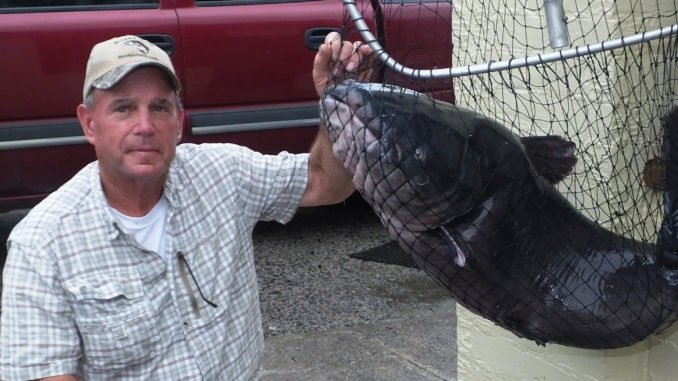
Trophy blue cats aren’t the only species biting
November is special on the Santee Cooper lakes for a variety of reasons. First and foremost, the fishing is fantastic for multiple species. Striper fishing improves from the excellent, already strong October bite, with more big, keeper-sized stripers on both live bait and schooling patterns. Catch-and-release days of 50 to 100 stripers were common last November. Big largemouth bass roam the shallows, and far fewer anglers are bass fishing, ensuring elbow room. Crappie action is slab-silly good in deep water.
November’s highlight may be a surprise to some, but not those who fish Lake Moultrie or Lake Marion regularly. Fishing for trophy blue catfish has to rank near the best of the year.
Kevin Davis at Black’s Camp said the November bite on big fish is consistent, and the top-end weight potential is off the chart.
“The November action on big blues in the past few years has been sensational,” said Davis (843-753-2231), “but that isn’t a fluke; it occurs every fall. We have anglers from throughout the Carolinas and beyond who know about it come to target the big cats. A lot of folks fish the stripers, but if you’re looking for a trophy blue catfish, something in excess of 70 pounds, November may be the best time to do it.”
The reality is that in one week a few Novembers ago, three blues in the 70- to 90-pound class were caught and released, all out of landings on the Diversion Canal. Both lakes pack potential to produce behemoth blues, but the lower end of Lake Marion and the deep waters of Lake Moultrie likely hold an edge in November because of abundant forage.
One of the guides who had an 82-pound blue in his boat that November was Linwood Thornhill, fishing out of Black’s Camp. Thornhill was working the far side of Lake Moultrie near Bonneau when the big fish bit.
Thornhill (843-753-2231) said one of the keys to catching big catfish this time of year is to work the deep-water ledges and drops.
“To target really big catfish, I like to stay in the deeper water during November,” Thornhill said. “Sometimes that’s difficult because drifting shallower water — before the bait drops into the deep holes — we frequently find hot action on good, eating-sized catfish. It’s not uncommon to catch a couple hundred pounds of decent-sized catfish, 5 to 20 pounds apiece, pretty quickly. But the best odds for hooking a trophy catfish are drift-fishing in the deep water.
“When drift-fishing, I prefer to see my catfish targets on the graph and have plenty of batfish as well. I don’t randomly drift-fish,” said Thornhill, who will pull multiple rigs at about 0.5 miles per hour off the drops and through deeper areas.
“I use a wide variety of baits, but cut mullet, white perch, herring and shad can all produce,” he said. “I like to give the fish options to determine what’s best on a daily basis. Catfish can bite a lot of different baits; sometimes, the big catfish can be finicky on what they’ll eat, so I’ll lay out a buffet for them.”
When the wind is not strong enough to push the boat at the speed Thornhill wants, he’ll put out drift socks in front of the boat to enable him to get the right speed, and then back-troll over his targets.
“I like to keep the speed right and control the way I cover an area,” he said. “Big catfish are usually holding in specific areas, and once I figure that target out, I want to keep my bait in that area. With my motor in reverse and pulling against one or two drift socks, I can control the speed and the course I drift.
“Catching big catfish is not a random type of fishing,” he said. “The presentation must be right, have forage and fish on the graph, use the right bait and quality tackle to handle the big fish once hooked.”
Gene Crawford, who also guides out of Black’s Camp, had an angler boat a 76-pound blue, just a couple of days before Thornhill’s catch. He was also drift-fishing Lake Moultrie’s deep water.
William Attaway was in a catfish tournament on Santee Cooper that same month, just before Crawford and Thornhill’s big fish, when he boated a 90.7-pound blue catfish. Attaway caught the big blue the second day of the two-day tournament.
“I caught the 90-pounder about 9:45 that morning, and I already had my tournament limit of five that day and was culling; the fishing was so good,” he said. “My (best) 10 fish for the tournament weighed 262 pounds, and we caught a lot of good catfish we released during that tournament.”
Attaway, who guides on South Carolina’s Lake Monticello, caught the 90-pounder on a big bream head; the white perch and gizzard shad he was using also produced quality catfish.
There were likely other trophy catfish taken that week and many more that November. Several other reports of big catfish in this size-class were received, but these three were all confirmed, photographed and released alive.
If fat catfish are not your favored target, the fall feast on forage is not limited to the whiskered fish. Fishing is great for stripers, crappie and largemouth bass. A lot of outdoorsmen have deer hunting on their minds, with good reason; the rut is still on during November.
November may just be the most undervalued month for catching big fish of multiple species at Santee Cooper.



Be the first to comment